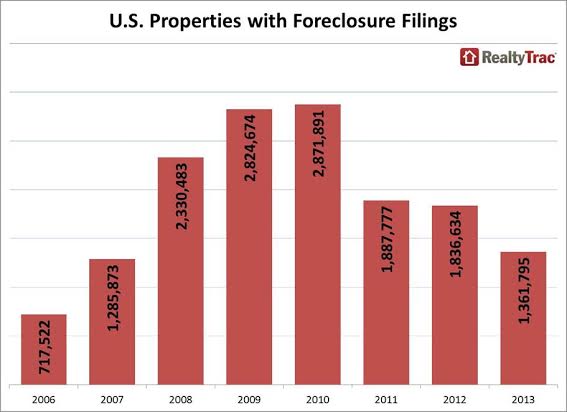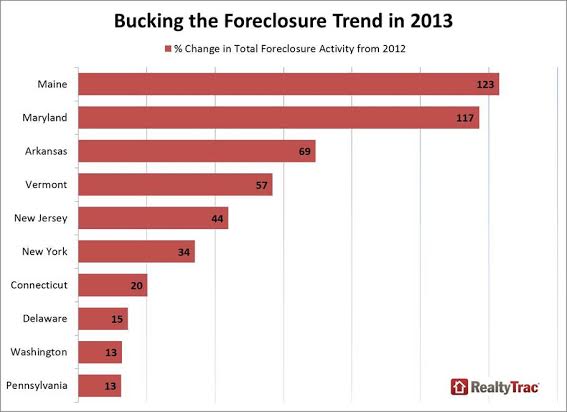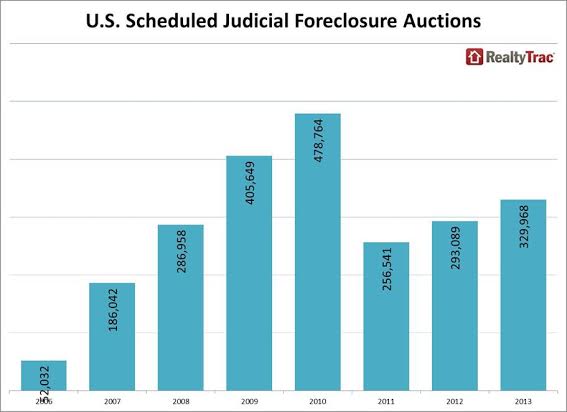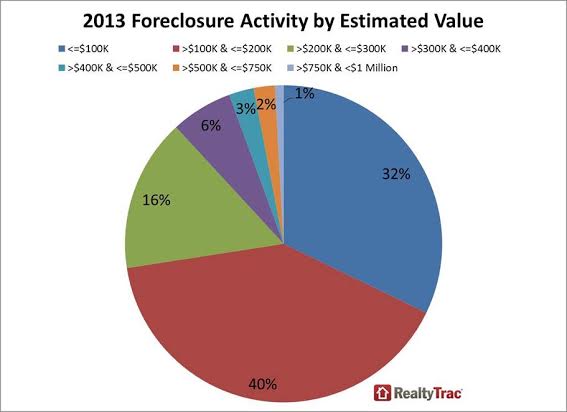Blog

Foreclosures at 5 year Low in 2013, but Some States Still Increasing
Is it finally over? rnWith foreclosure filings throughout 2013 reported by RealtyTrac to be atrnthe lowest annual level since 2007, one might begin to hope the housing crisisrnhas ended. However the company alsornreports that overall foreclosure activity increased last year in 10 states andrnscheduled foreclosure auctions in judicial process states were the highest inrnthree years.</p
RealtyTrac released its Year-End 2013 U.S. Foreclosure Market Report this morning showingrnthat an aggregate of 1,361,795 default notices, scheduled auctions, and bankrnrepossessions or completed foreclosures were filed during the year, a decreasernof 26 percent from the level in 2012 and 53 percent below the peak number ofrnfilings in 2010. The last time filingsrnwere lower was in 2007 when 1.3 filings were recorded. </p
 </p
</p
Looked at another way, in 2013 1.04 percent of U.S.rnhousing units or one in every 96 received at least one foreclosure filingrnduring the year. In 2012 filingsrnaffected 1.39 percent of housing units and in 2010 2.23 percent. RealtyTrac says that over the eight yearsrnending in December 2013 10.9rnmillion U.S. properties have started the foreclosure process and 5.6 millionrnhave been repossessed by lenders through foreclosure.</p
The ten states in which foreclosure activity increasedrnin 2013 were Maryland which had 117 percent more filings than it had in 2012,rnNew Jersey (up 44 percent), New York (+34 percent, Connecticut (+20 percent)rnand Washington and Pennsylvania which were each up 13 percent. </p
 </p
</p
Scheduled foreclosure auctions (NFS)rnwere the only foreclosure document type in which the frequency of filings nationwidernrose in 2013. This was largely due to arn13 percent increase of these filings in judicial foreclosure states, thernhighest level in this subset since 2010. rnSome of the states in which NFS spiked were Maryland wherernscheduled auctions rose by 107 percent, New Jersey, up 64 percent, Connecticutrn(+55 percent) and Florida (+53 percent.) </p
 </p
</p
Florida and Nevada continued theirrnlong tenure among the top two or three states for foreclosure filings, rankingrnfirst and second respectively in 2013. In Florida 3.01 percent of all housing unitsrnreceived a foreclosure filing during the year and in Nevada it was 2.16rnpercent. Other states making up the toprnfive were Illinois (1.89 percent), Maryland (1.57 percent), and Ohio (1.53rnpercent).</p
The average estimated value of arnproperty receiving a foreclosure filing in 2013 was $191,693 at the time of thernforeclosure filing, up 1 percent from the average value in 2012, and thernaverage estimated market value of properties that received foreclosure filingsrnin 2013 has increased 10 percent since the foreclosure notice was filed.</p
 </p
</p
The timeline for completing arnforeclosure continued to increase to a current record high of 564 days. States where foreclosures took the longest inrn2013 were New York (1,029 days), New Jersey (999 days) and Florida (944rndays). </p
“Millions of homeowners are stillrnliving in the shadow of the massive foreclosure crisis that the countryrnexperienced over the past eight years since the housing price bubble burst -rnboth in the form of homes lost to directly to foreclosure as well as homernequity lost as a result of a flood of discounted distressed sales,” said Daren Blomquist,rnvice president at RealtyTrac. “But the shadow cast by the foreclosurerncrisis is shrinking as fewer distressed properties enter foreclosure andrnproperties already in foreclosure are poised to exit in greater numbers in 2014rngiven the greater numbers of scheduled foreclosure auctions in 2013 in judicialrnstates – which account for the bulk of U.S. foreclosure inventory. </p
“The push to schedule these auctionsrnis certainly coming at an opportune time for the foreclosing lenders,”rnBlomquist added. “There is unprecedented demand from institutional investorsrnwilling to pay with cash to buy at the foreclosure auction, helping to raisernthe value of properties with a foreclosure filing in 2013 by an average of 10rnpercent nationwide.”</p
Looking at individual filing types, arntotal of 747,728 U.S. properties started the foreclosure process in 2013, downrn33 percent from 2012 to the lowest annual total since RealtyTrac began reportingrnon foreclosure starts in 2006. Thirteen statesrnbucked the downward trend including Maryland (up 194 percent from 2012),rnArkansas (+64 percent), New Jersey (+54), Connecticut (47 percent), and NewrnYork (+42 percent). States with thernsignificant decreases in foreclosure starts included California (-60 percent),rnArizona (-59 percent), Colorado (-58 percent), Georgia (-47 percent) andrnMichigan (-42 percent.) All five arernnon-judicial states.</p
Bank repossessions totaled 462,970rnin 2013, down 31 percent from 2012 and the lowest number since 2007, but 12rnstates saw completed foreclosures increase including Maryland (+57 percent),lrnArkansas (+43 percent), Washington (+30 percent) and New York and Oklahoma withrnrespective increases of 28 and 26 percent. The more significant decreases were inrnCalifornia (-60 percent), Texas (-56 Percent), Arizona (-52 percent), Georgiarn(-50 percent), Michigan (-47 percent) and Illinois (-33 percent). </p
In December 2013, more than 1.2rnmillion properties nationwide were in some stage of foreclosure or bank owned,rndown 19 percent from December 2012 and 44 percent below the peak of more thanrn2.2 million in December 2010. Florida,rnCalifornia, Illinois, New York, and Ohio had the largest numbers of propertiesrnin the foreclosure inventory, together accounting for 29 percent of thernnational total.</p
Lenders with the most inventory ofrnbank-owned (REO) properties based on the name listed on the foreclosurerndocuments were the government-backed entities of Fannie Mae, Freddie Mac andrnthe U.S. Department of Housing and Urban Development (HUD), with a combined 41rnpercent of all REO inventory. Other top beneficiaries were Bank of America andrnWells Fargo (each with 11 percent of all active REO inventory), Chase (8rnpercent), US BankCorp (7 percent), Deutsche Bank (5 percent), and CitiGroup (4rnpercent).</p
Miami had the highest foreclosurernactivity among metropolitan areas with a total of 96,710 filings during thernyear, a 6 percent annual increase. Otherrnlarge cities with high levels of activity included seven in Floridarn(Jacksonville, Orlando, Palm Bay-Melbourne-Titusville, Port St. Lucie, Tampa,rnOcala, and Sarasota.) Rounding out therntop ten were Rockford, Illinois at 8th place and Las Vegas in 9th. Of the 209 metro areas tracked in thernreport, 51 bucked the national trend and posted increasing foreclosure activityrnin 2013 compared to 2012.
All Content Copyright © 2003 – 2009 Brown House Media, Inc. All Rights Reserved.nReproduction in any form without permission of MortgageNewsDaily.com is prohibited.
Latest Articles
By John Gittelsohn August 24, 2020, 4:00 AM PDT Some of the largest real estate investors are walking away from Read More...
Late-Stage Delinquencies are SurgingAug 21 2020, 11:59AM Like the report from Black Knight earlier today, the second quarter National Delinquency Survey from the Read More...
Published by the Federal Reserve Bank of San FranciscoIt was recently published by the Federal Reserve Bank of San Francisco, which is about as official as you can Read More...

Comments
Leave a Comment